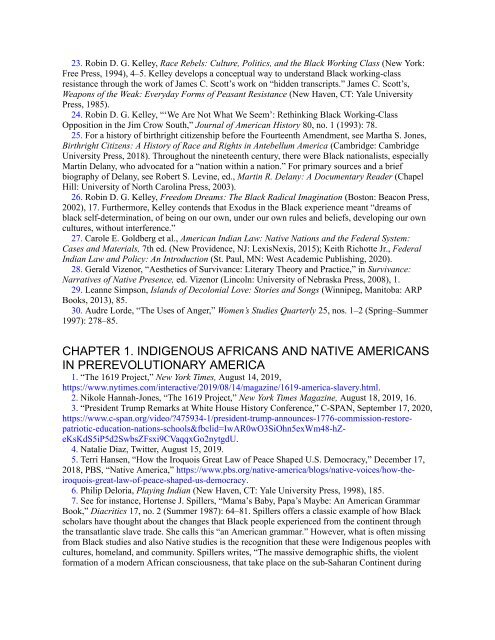You also want an ePaper? Increase the reach of your titles
YUMPU automatically turns print PDFs into web optimized ePapers that Google loves.
23. Robin D. G. Kelley, Race Rebels: Culture, Politics, and <strong>the</strong> Black Working Class (New York:<br />
Free Press, 1994), 4–5. Kelley develops a conceptual way to understand Black working-class<br />
resistance through <strong>the</strong> work <strong>of</strong> James C. Scott’s work on “hidden transcripts.” James C. Scott’s,<br />
Weapons <strong>of</strong> <strong>the</strong> Weak: Everyday Forms <strong>of</strong> Peasant Resistance (New Haven, CT: Yale University<br />
Press, 1985).<br />
24. Robin D. G. Kelley, “‘We Are Not What We Seem’: Rethinking Black Working-Class<br />
Opposition in <strong>the</strong> Jim Crow South,” Journal <strong>of</strong> American <strong>History</strong> 80, no. 1 (1993): 78.<br />
25. For a history <strong>of</strong> birthright citizenship before <strong>the</strong> Fourteenth Amendment, see Martha S. Jones,<br />
Birthright Citizens: A <strong>History</strong> <strong>of</strong> Race and Rights in <strong>An</strong>tebellum America (Cambridge: Cambridge<br />
University Press, 2018). Throughout <strong>the</strong> nineteenth century, <strong>the</strong>re were Black nationalists, especially<br />
Martin Delany, who advocated for a “nation within a nation.” For primary sources and a brief<br />
biography <strong>of</strong> Delany, see Robert S. Levine, ed., Martin R. Delany: A Documentary Reader (Chapel<br />
Hill: University <strong>of</strong> North Carolina Press, 2003).<br />
26. Robin D. G. Kelley, Freedom Dreams: The Black Radical Imagination (Boston: Beacon Press,<br />
2002), 17. Fur<strong>the</strong>rmore, Kelley contends that Exodus in <strong>the</strong> Black experience meant “dreams <strong>of</strong><br />
black self-determination, <strong>of</strong> being on our own, under our own rules and beliefs, developing our own<br />
cultures, without interference.”<br />
27. Carole E. Goldberg et al., American Indian Law: Native Nations and <strong>the</strong> Federal System:<br />
Cases and Materials, 7th ed. (New Providence, NJ: LexisNexis, 2015); Keith Richotte Jr., Federal<br />
Indian Law and Policy: <strong>An</strong> Introduction (St. Paul, MN: West Academic Publishing, 2020).<br />
28. Gerald Vizenor, “Aes<strong>the</strong>tics <strong>of</strong> Survivance: Literary Theory and Practice,” in Survivance:<br />
Narratives <strong>of</strong> Native Presence, ed. Vizenor (Lincoln: University <strong>of</strong> Nebraska Press, 2008), 1.<br />
29. Leanne Simpson, Islands <strong>of</strong> Decolonial Love: Stories and Songs (Winnipeg, Manitoba: ARP<br />
Books, 2013), 85.<br />
30. Audre Lorde, “The Uses <strong>of</strong> <strong>An</strong>ger,” Women’s Studies Quarterly 25, nos. 1–2 (Spring–Summer<br />
1997): 278–85.<br />
CHAPTER 1. INDIGENOUS AFRICANS AND NATIVE AMERICANS<br />
IN PREREVOLUTIONARY AMERICA<br />
1. “The 1619 Project,” New York Times, August 14, 2019,<br />
https://www.nytimes.com/interactive/2019/08/14/magazine/1619-america-slavery.html.<br />
2. Nikole Hannah-Jones, “The 1619 Project,” New York Times Magazine, August 18, 2019, 16.<br />
3. “President Trump Remarks at White House <strong>History</strong> Conference,” C-SPAN, September 17, 2020,<br />
https://www.c-span.org/video/?475934-1/president-trump-announces-1776-commission-restorepatriotic-education-nations-schools&fbclid=IwAR0wO3SiOhn5exWm48-hZeKsKdS5iP5d2SwbsZFsxi9CVaqqxGo2nytgdU.<br />
4. Natalie Diaz, Twitter, August 15, 2019.<br />
5. Terri Hansen, “How <strong>the</strong> Iroquois Great Law <strong>of</strong> Peace Shaped U.S. Democracy,” December 17,<br />
2018, PBS, “Native America,” https://www.pbs.org/native-america/blogs/native-voices/how-<strong>the</strong>iroquois-great-law-<strong>of</strong>-peace-shaped-us-democracy.<br />
6. Philip Deloria, Playing Indian (New Haven, CT: Yale University Press, 1998), 185.<br />
7. See for instance, Hortense J. Spillers, “Mama’s Baby, Papa’s Maybe: <strong>An</strong> American Grammar<br />
Book,” Diacritics 17, no. 2 (Summer 1987): 64–81. Spillers <strong>of</strong>fers a classic example <strong>of</strong> how Black<br />
scholars have thought about <strong>the</strong> changes that Black people experienced from <strong>the</strong> continent through<br />
<strong>the</strong> transatlantic slave trade. She calls this “an American grammar.” However, what is <strong>of</strong>ten missing<br />
from Black studies and also Native studies is <strong>the</strong> recognition that <strong>the</strong>se were <strong>Indigenous</strong> peoples with<br />
cultures, homeland, and community. Spillers writes, “The massive demographic shifts, <strong>the</strong> violent<br />
formation <strong>of</strong> a modern African consciousness, that take place on <strong>the</strong> sub-Saharan Continent during


















